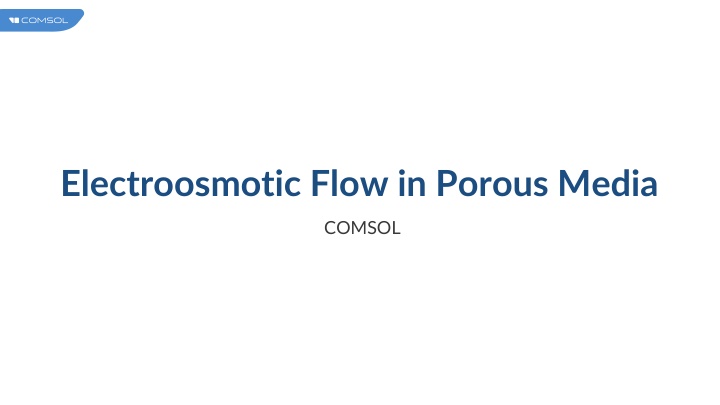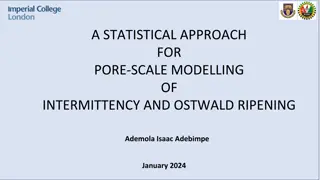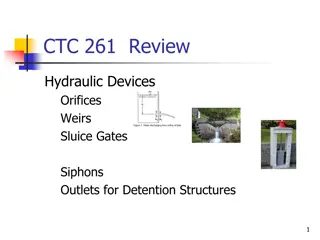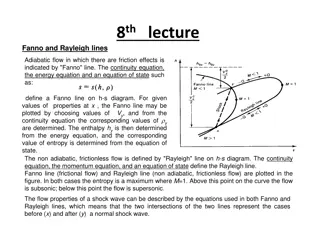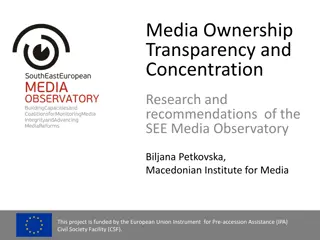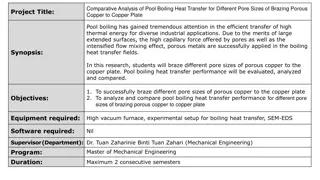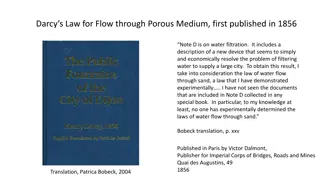Electroosmotic Flow in Porous Media Modeling
This example demonstrates the modeling of electroosmotic flow in porous media, combining pressure-driven and electroosmotic flow components in a system containing electrodes generating an electric field. Explore the geometry, electric currents, electroosmotic pressure, transport of diluted species, and velocity distributions in response to different driving forces.
Download Presentation

Please find below an Image/Link to download the presentation.
The content on the website is provided AS IS for your information and personal use only. It may not be sold, licensed, or shared on other websites without obtaining consent from the author.If you encounter any issues during the download, it is possible that the publisher has removed the file from their server.
You are allowed to download the files provided on this website for personal or commercial use, subject to the condition that they are used lawfully. All files are the property of their respective owners.
The content on the website is provided AS IS for your information and personal use only. It may not be sold, licensed, or shared on other websites without obtaining consent from the author.
E N D
Presentation Transcript
Introduction This example treats the modeling of electroosmotic flow in porous media The system consists of a compartment of sintered porous material and two electrodes that generate an electric field The cell combines pressure-driven and electroosmotic flow
Model Definition The figure shows the system s geometry made up of a domain of porous material containing the electrolyte and two electrodes that generate a potential difference The conductivity is very small, and the model assumes that the effects of electrochemical reactions at the electrode surfaces are negligible Geometry 1
Model Definition Electric Currents
Model Definition Electroosmotic Pressure
Model Definition Transport of Diluted Species
Results The upper plot in the figure shows the flow distribution in the porous structure when only the electric field acts as a driving force In the lower plot, it is instead the pressure gradient that drives the flow Velocity distributions in the cell with an applied electric field (top) and an applied pressure difference (bottom). The unit for the magnitude surface plot is mm/s
Results In both cases, the velocity is large around the corners of the electrodes, where the field strength is large and the effect of the decrease in the geometry s cross section is most pronounced A comparison of the maximum flow-velocity values shows that the pressure gradient is the dominating driving force Velocity distributions in the cell with an applied electric field (top) and an applied pressure difference (bottom). The unit for the magnitude surface plot is mm/s
Results The figure shows the concentration field in the case where both pressure and electroosmotic forces are included The figure shows that the migration of the charged tracer also influences the transport rate Concentration distribution in the domain at different times after injection. The effects of diffusion, convection, and migration deform the initial bell-shaped pulse
Results In this case, the tracer is transported both by the movement of the flow, due to pressure and electroosmotic terms, and the electrophoretic effect on the charged tracer itself Concentration distribution in the domain at different times after injection. The effects of diffusion, convection, and migration deform the initial bell-shaped pulse
Results At t = 0, the tracer is introduced as a bell-shaped vertical istribution near the inlet In the subsequent simulation, this distribution is sheared and transported by diffusion, migration, and convection Concentration distribution in the domain at different times after injection. The effects of diffusion, convection, and migration deform the initial bell-shaped pulse
Results The figure shows the cross sections of the pulse along a line at y = 2.5 mm for the times t =0, 0.5 s, 1.0 s, 1.5 s, and t = 2.0 s Diffusion, mainly numerical diffusion, smears out the pulse at t = 0 s t = 0.6 s t = 1.2 s t = 1.8 s, while migration and convection mainly translate and shear it, depending on the pressure and the electric field Cross-section plot of the concentration along a horizontal line at y = 2.5 mm for the times t = 0 (blue solid), 0.5 s, 1.0 s, 1.5 s, and 2.0 s
